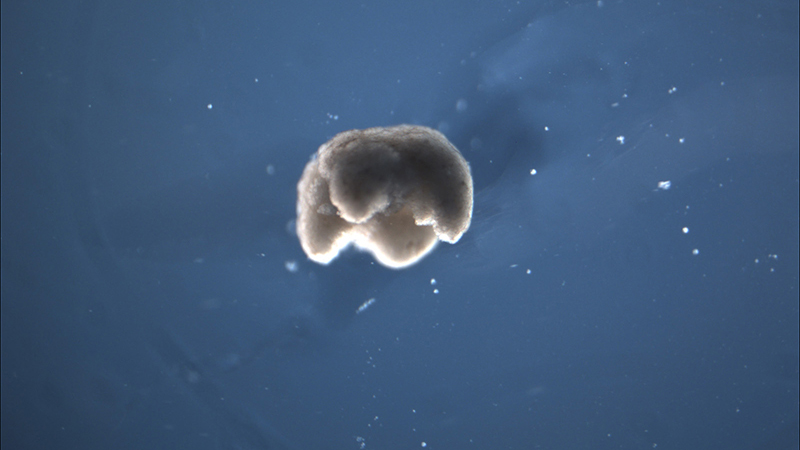World's First 'Living Machine' Created Using Frog Cells and Artificial Intelligence
Scientists used computer algorithms to "evolve" an organism that's made of 100% frog DNA — but it isn't a frog.

What happens when you take cells from frog embryos and grow them into new organisms that were "evolved" by algorithms? You get something that researchers are calling the world's first "living machine."
Though the original stem cells came from frogs — the African clawed frog, Xenopus laevis — these so-called xenobots don't resemble any known amphibians. The tiny blobs measure only 0.04 inches (1 millimeter) wide and are made of living tissue that biologists assembled into bodies designed by computer models, according to a new study.
These mobile organisms can move independently and collectively, can self-heal wounds and survive for weeks at a time, and could potentially be used to transport medicines inside a patient's body, scientists recently reported.
Related: The 6 Strangest Robots Ever Created
"They're neither a traditional robot nor a known species of animal," study co-author Joshua Bongard, a computer scientist and robotics expert at the University of Vermont, said in a statement. "It's a new class of artifact: a living, programmable organism."
Algorithms shaped the evolution of the xenobots. They grew from skin and heart stem cells into tissue clumps of several hundred cells that moved in pulses generated by heart muscle tissue, said lead study author Sam Kriegman, a doctoral candidate studying evolutionary robotics in the University of Vermont's Department of Computer Science, in Burlington.
"There's no external control from a remote control or bioelectricity. This is an autonomous agent — it's almost like a wind-up toy," Kriegman told Live Science.
Sign up for the Live Science daily newsletter now
Get the world’s most fascinating discoveries delivered straight to your inbox.
Biologists fed a computer constraints for the autonomous xenobots, such as the maximum muscle power of their tissues, and how they might move through a watery environment. Then, the algorithm produced generations of the tiny organisms. The best-performing bots would "reproduce" inside the algorithm. And just as evolution works in the natural world, the least successful forms would be deleted by the computer program.
"Eventually, it was able to give us designs that actually were transferable to real cells. That was a breakthrough," Kriegman said.
The study authors then brought these designs to life, piecing stem cells together to form self-powered 3D shapes designed by the evolution algorithm. Skin cells held the xenobots together, and the beating of heart tissue in specific parts of their "bodies" propelled the 'bots through water in a petri dish for days, and even weeks at a stretch, without needing additional nutrients, according to the study. The 'bots were even able to repair significant damage, said Kriegman.
"We cut the living robot almost in half, and its cells automatically zippered its body back up," he said.
"We can imagine many useful applications of these living robots that other machines can't do," said study co-author Michael Levin, director of the Center for Regenerative and Developmental Biology at Tufts University in Massachusetts. These might include targeting toxic spills or radioactive contamination, collecting marine microplastics or even excavating plaque from human arteries, Levin said in a statement.
Creations that blur the line between robots and living organisms are popular subjects in science fiction; think of the killer machines in the "Terminator" movies or the replicants from the world of "Blade Runner." The prospect of so-called living robots — and using technology to create living organisms — understandably raises concerns for some, said Levin.
"That fear is not unreasonable," Levin said. "When we start to mess around with complex systems that we don't understand, we're going to get unintended consequences."
Nevertheless, building on simple organic forms like the xenobots could also lead to beneficial discoveries, he added.
"If humanity is going to survive into the future, we need to better understand how complex properties, somehow, emerge from simple rules," Levin said.
The findings were published online Jan. 13 in the journal Proceedings of the National Academy of Sciences.
- 24 Underwater Drones – The Boom in Robotics Beneath the Waves
- Super-Intelligent Machines: 7 Robotic Futures
- Best Robot Kits for Kids
Originally published on Live Science.


Mindy Weisberger is an editor at Scholastic and a former Live Science channel editor and senior writer. She has reported on general science, covering climate change, paleontology, biology and space. Mindy studied film at Columbia University; prior to Live Science she produced, wrote and directed media for the American Museum of Natural History in New York City. Her videos about dinosaurs, astrophysics, biodiversity and evolution appear in museums and science centers worldwide, earning awards such as the CINE Golden Eagle and the Communicator Award of Excellence. Her writing has also appeared in Scientific American, The Washington Post and How It Works Magazine. Her book "Rise of the Zombie Bugs: The Surprising Science of Parasitic Mind Control" will be published in spring 2025 by Johns Hopkins University Press.











